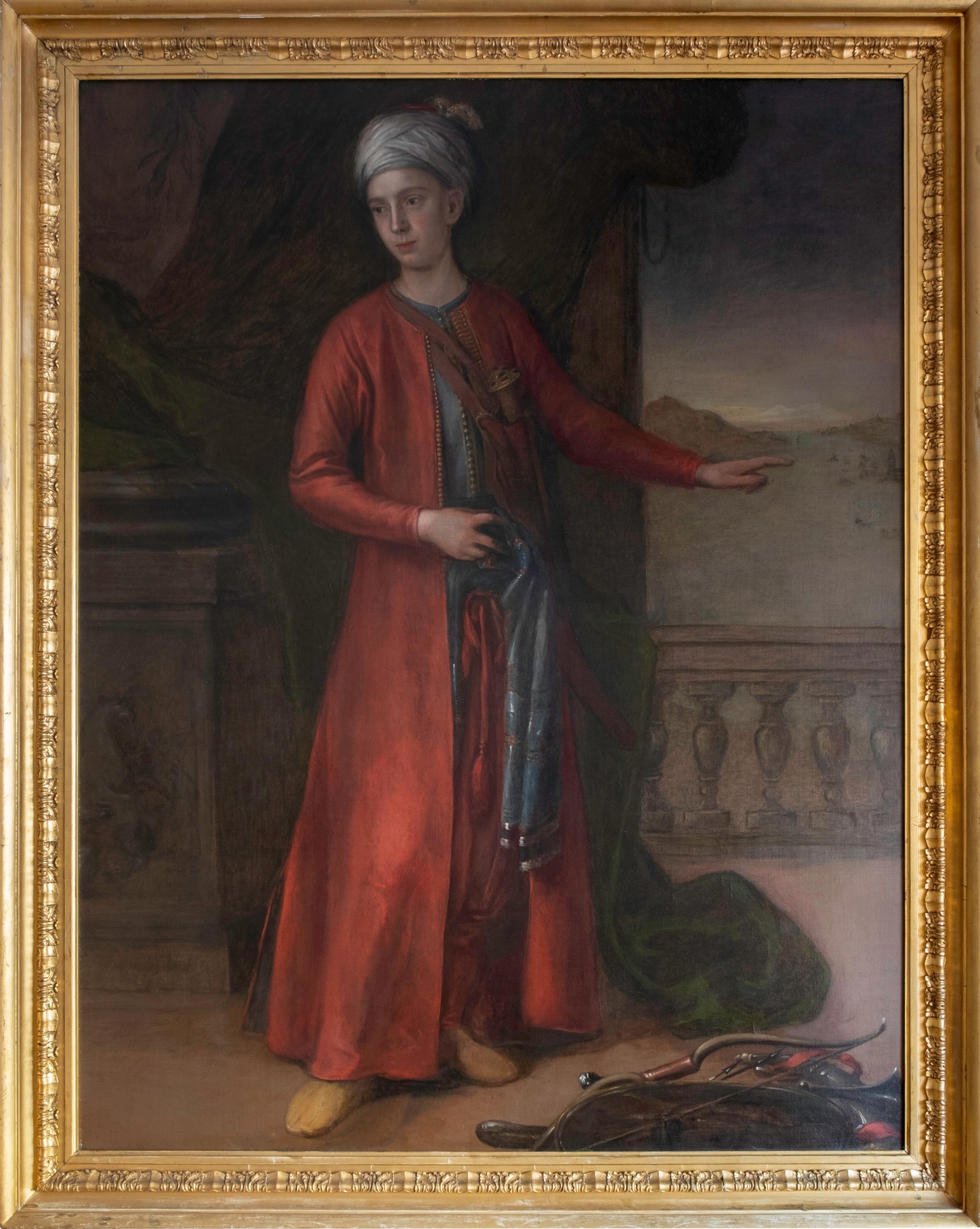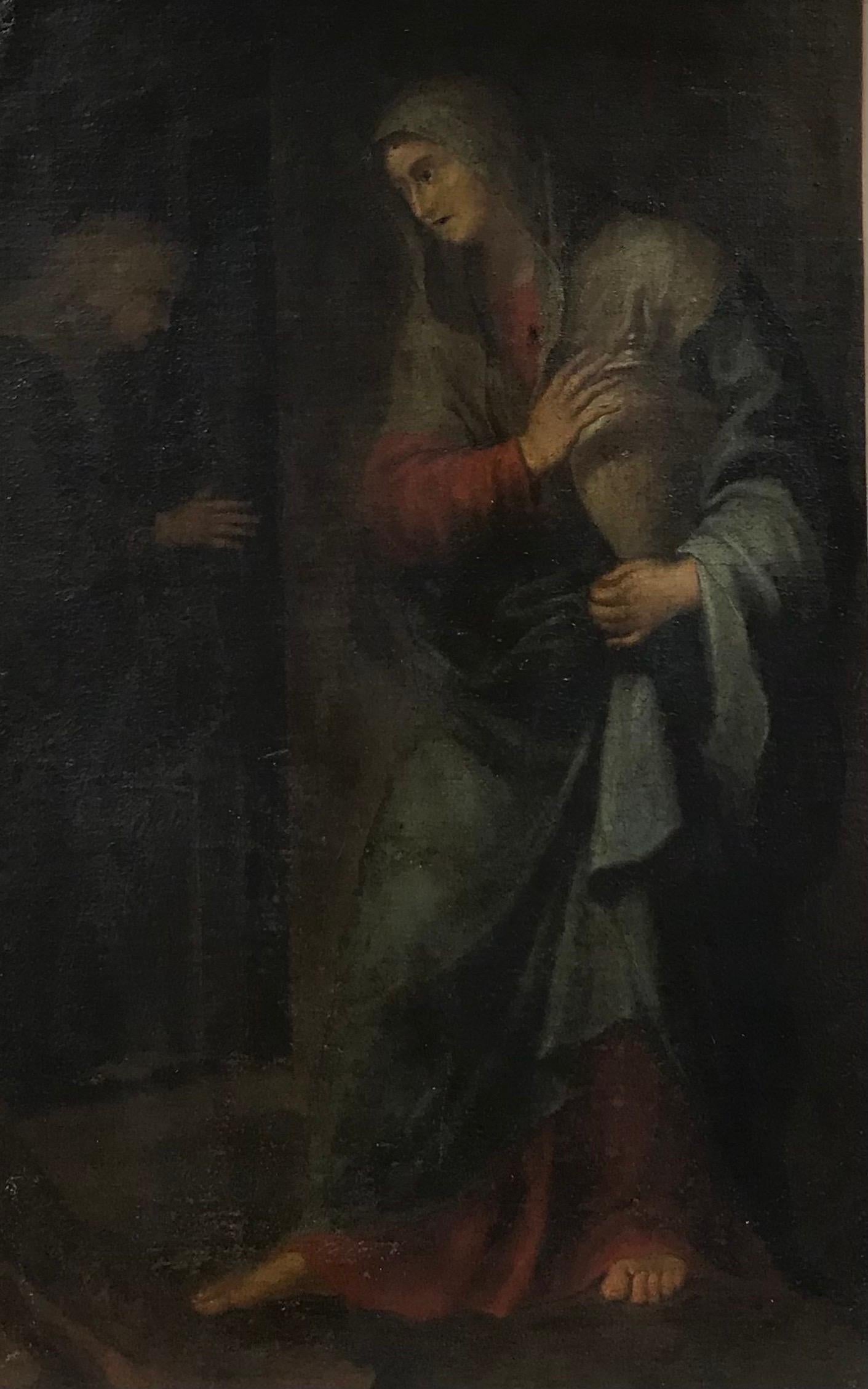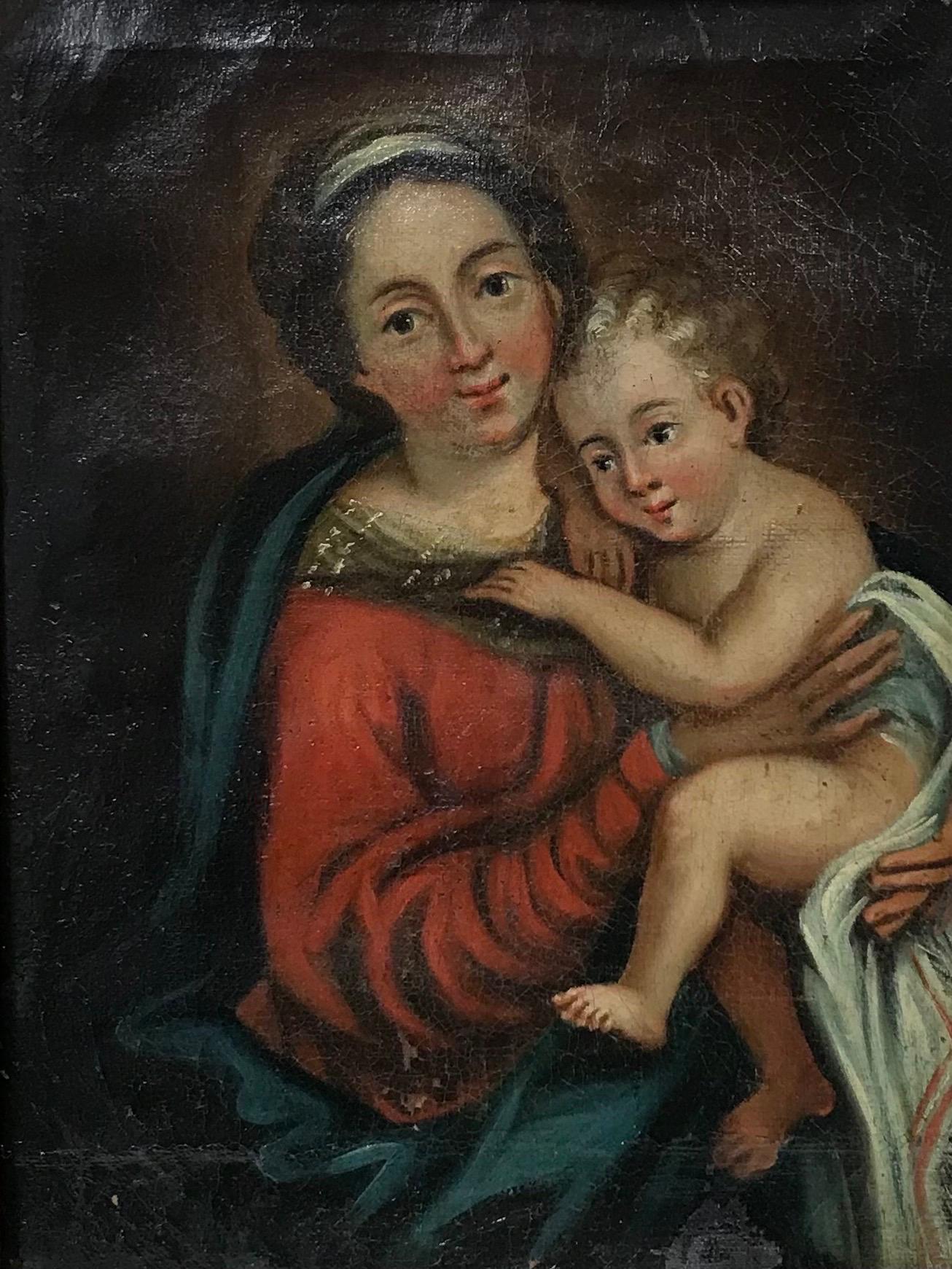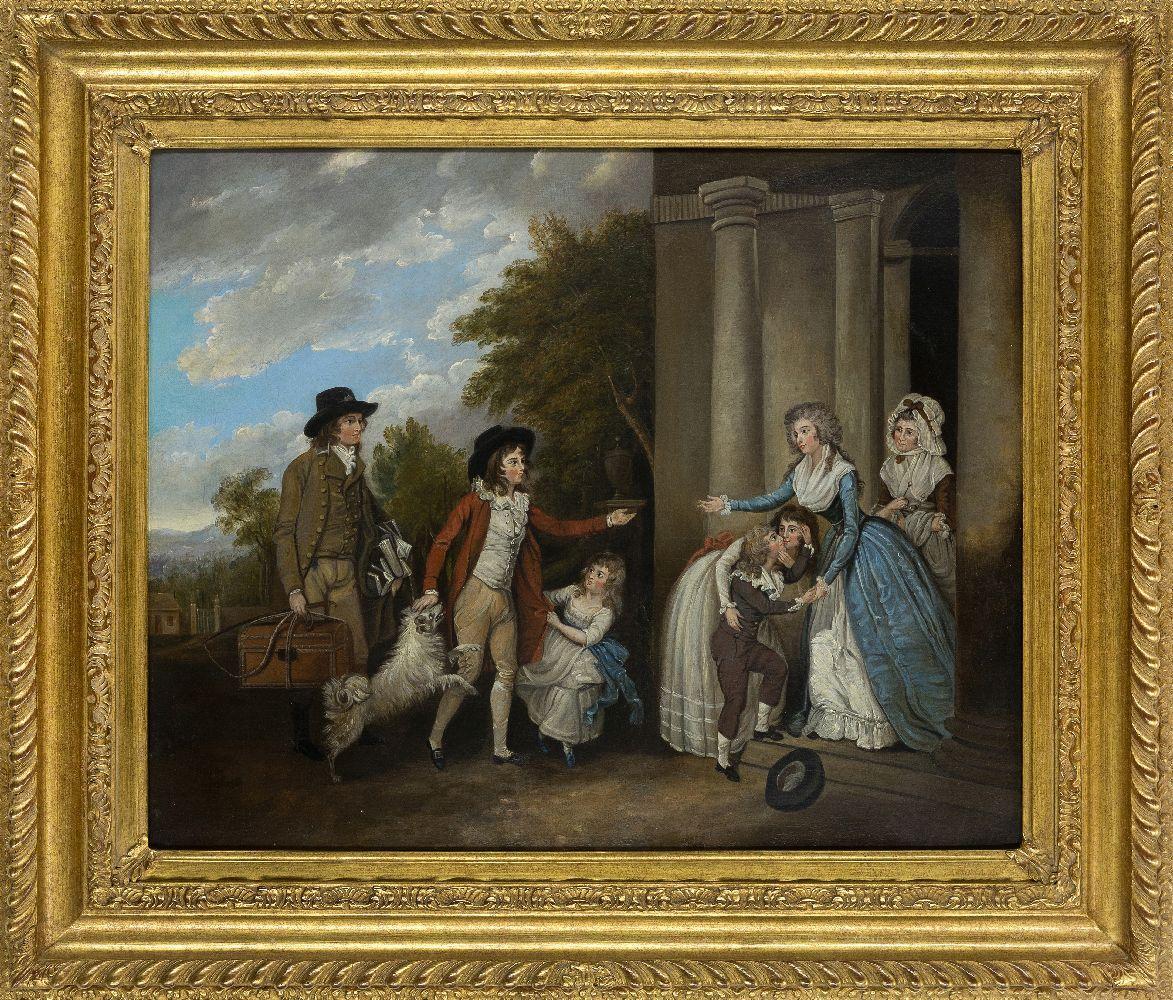Items Similar to Madonna and Child with St Catherine and Putti - Italian 17thC art oil painting
Want more images or videos?
Request additional images or videos from the seller
1 of 15
Giuseppe Bartolomeo ChiariMadonna and Child with St Catherine and Putti - Italian 17thC art oil painting Circa 1684
Circa 1684
About the Item
This stunning Italian 17th century Old Master religious oil painting is by Baroque artist Giuseppe Bartolomeo Chari. Painted circa 1684 it is a large and vibrant oil painting of the Madonna and child. To their left is Saint Catherine and to their right four putti or cherubs look upon a sleeping Jesus. The detail in all the figures faces and hair and the colouring is just superb, especially the Madonna's sumptuous blue robe. A really fabulous 17th century religious work with previous full attribution and excellent provenance which was once attributed to Carlo Maratta (1625-1713).
Provenance. With Vangelisti, Lucca, Italy, 1966, from whom acquired by the family of the previous owner, and thence by descent.
Red seal stamp verso
Christies April 15th 1912
Christies March 23 1956
Condition. Oil on Canvas. Image size 44 x 54 inches unframed and in good condition.
Frame. Housed in an original Carlo Maratta frame, 62 inches by 52 inches framed and in good condition.
Giuseppe Bartolomeo Chiari (1654-1727), also known simply as Giuseppe Chiari, was an Italian painter of the late-Baroque period, active mostly in Rome. Born in Rome, he was one of the main assistants, along with Giuseppe Passeri and Andrea Procaccini, in the studio of an elder Carlo Maratta. His father had opposed the career, but his mother, on the recommendation of a painter named Carlo Antonio Gagliani. By the age of 22, he had frescoed the lateral lunettes (Birth of Virgin and Adoration of Magi) of the Marchionni chapel in the church of Santa Maria del Suffragio. He also painted the ceiling of a chapel in Santa Maria in Cosmedin. He frescoed rooms in the Palazzo Barberini to allegorical sketches of Bellori of Aurora leading Apollo and chariot with time and seasons with extensive interweaving of heraldic symbols, including bees (symbol of Barberini); two-headed eagle alighting on globe with blue and white stripes (symbol of the family of Vittorio Ottoboni; crossed keys under baldachin (symbol of Pope Alexander VIII); a golden fleece (symbol of award given to Taddeo Barberini; a column (symbol of the Colonna family); sun and laurels (symbols of Urban VIII), and post (symbols of the Pignatelli family. He also frescoed the Palaces Colonna and Spada with scenes based on Ovid's Metamorphoses. He additionally frescoed the Villa di Marchese Torri outside of Porta San Pancrazio in collaboration with landscape artist Jan van Bloemen; as well as the church of San Silvestro in Capite with Madonna and child with Saint Anthony performing miracles and Pope Stephen I destroying temple of Mars with lightning (1696) for Santa Maria del Suffragio (where he completed Niccolò Berrettoni's fresco). He also painted for Santa Maria in Posterola, Santa Maria di Loreto, San Salvatore in Lauro, and an Assumption for Santa Maria del Montesanto. For Basilica di San Clemente, he painted a St Clement in Glory for pope Clement XI. He also prepared the cartoons for the mosaics in the lateral nave of the Basilica of Saint Peter’s and San Giovanni Laterano with the oval of Prophet Obdiah listening to trumpet of Judgement Day. He also painted a Vision of St John in the chapel of the Presentazione for the Duomo di Urbino. He was a teacher of William Kent, Paolo Anesi, and Giovanni Andrea Lazzarini. His studio is described as highly frequented by French artists. He became director or principe of the Accademia di San Luca (1723–25).
- Creator:Giuseppe Bartolomeo Chiari (1654 - 1727, Italian)
- Creation Year:Circa 1684
- Dimensions:Height: 62 in (157.48 cm)Width: 52 in (132.08 cm)Depth: 2 in (5.08 cm)
- Medium:
- Movement & Style:
- Period:
- Condition:
- Gallery Location:London, GB
- Reference Number:1stDibs: LU853114380782
About the Seller
5.0
Platinum Seller
These expertly vetted sellers are 1stDibs' most experienced sellers and are rated highest by our customers.
1stDibs seller since 2018
402 sales on 1stDibs
Typical response time: 1 hour
- ShippingRetrieving quote...Ships From: London, United Kingdom
- Return PolicyA return for this item may be initiated within 14 days of delivery.
More From This SellerView All
- The Annunciation to the Shepherds - Dutch 17thC art religious oil paintingLocated in London, GBThis wonderful 17th century Old Master religious oil painting is attributed to Dutch Golden Age artist Benjamin Gerritsz Cuyp. Painted circa 1633 it is entitled The Annunciation to t...Category
17th Century Old Masters Portrait Paintings
MaterialsOil
- Charity - Royal Academy exhib. 19thC art Pre-Raphaelite portrait oil paintingBy Rudolf LehmannLocated in London, GBThis stunning circular 19th century oil painting is by noted prolific Royal Academy exhibited artist Rudolf Lehmann. A portrait artist, German born Lehmann moved to England in 1866 w...Category
19th Century Pre-Raphaelite Portrait Paintings
MaterialsOil
- Portrait of a lady - British 50's Post Impressionist oil painting blonde womanBy Constance Anne ParkerLocated in London, GBA super circa 1955 British portrait oil painting in tones of blue and brown. A very evocative period portrait of a woman painted by British listed female artist Constance Anne Parke...Category
20th Century Realist Portrait Paintings
MaterialsOil
- Two Women in a Cafe - British 1930's art oil portrait painting Spain jugs pinkBy Darsie JappLocated in London, GBAn original oil on canvas by the British listed artist Darsie Japp. It was painted circa 1930 and depicts two woman at a table having a drink. A very evocative inter war oil painting. Provenance. James Bourlet Framers. Sotheby 12.11.86. Condition. Oil on canvas, 28 inches by 22 inches unframed and in excellent condition. Housed in a gallery frame, 36 inches by 30 inches framed in good condition. Darsie Japp (1888-1973) was born in Liverpool and attended St John's College of the University of Oxford. After he graduated he worked in the offices of his father's shipping company in the City of London between 1904 and 1907. Whilst working in the City Japp studied at the night school of the Lambeth School of Art under Philip Connard. Japp studied at the Slade School of Art between 1908 and 1909, where he became friends with his fellow student Stanley Spencer and would often visit him in his home at Cookham in Berkshire. Japp specialised in landscape and figure paintings and exhibited with the New English Art Club of which he became a member in 1919. At the start of the First World War Japp joined the British Army and, eventually, became a Major in the Royal Field Artillery commanding an artillery battery in Macedonia, for which he was awarded the Military Cross...Category
1910s Impressionist Figurative Paintings
MaterialsOil
- At the Foot of the Statue - Scottish art Impressionist figurative oil paintingBy William Strang, R.A., R.E.Located in London, GBA fine large oil painting by Scottish listed artist William Strang. This is a super evocative oil on canvas which depicts a family at "The Foot of the Statue". It was exhibited in 1904 in Bradford exhibition of fine arts lent by L W Hodson of Wolverhampton who was a patron of his work. This is a fine example of an early 20th century Scottish oil with good subject. It is a good size and signed. This wouldn't be out of place in Kelvingrove Gallery in Glasgow. Signed lower left. Provenance. Bradford Art Gallery 1904. Sotheby 19th June 2002 Guide price £20000-30000GBP. Condition. Oil on canvas. Image size 30 inches by 25 inches and in excellent condition. Housed in a fine period frame, 39 by 34 inches framed and in good condition. William Strang (1859-1921) was born at Dumbarton, the son of Peter Strang, builder, and educated at the Dumbarton Academy. He worked for fifteen months in the counting-house of a firm of shipbuilders before going to London in 1875 when he was sixteen. There he studied art under Alphonse Legros at the Slade School for six years. Strang became assistant master in the etching class, and had great success as an etcher. He was one of the original members of the Royal Society of Painter-Etchers, and his work was a part of their first exhibition in 1881. Some of his early plates were published in The Portfolio and other art magazines. He worked in many manners, etching, dry point, mezzotint, sand-ground mezzotint, and burin engraving. Lithography and wood-cutting were also used by him to create pictures. He cut a large wood engraving of a man ploughing, later published by the Art for Schools Association. A privately produced catalogue of his engraved work contained more than three hundred items. Amongst his earlier works were Tinkers, St. Jerome, A Woman Washing Her Feet, An Old Book-stall with a Man Lighting His Pipe from a Flare, and The Head of a Peasant Woman on sand-ground mezzotint. Later plates such as Hunger, The Bachelor's End and The Salvation Army were also important. Some of his best etchings were done as series—one of the earliest, illustrating poet William Nicholson's Ballad of Aken Drum, is remarkable for clear, delicate workmanship in the shadow tones, showing great skill and power over his materials, and for strong drawing. Another praised series was The Pilgrim's Progress, revealing austere sympathy with John Bunyan's teaching. Samuel Taylor Coleridge's Ancient Mariner and Strang's own Allegory of Death and The Plowman's Wife, have served him with suitable imaginative subjects. Some of Rudyard Kipling's stories were also illustrated by him, and his likeness of Kipling was one of his most successful portrait plates. Other etched portraits included those of Ernest Sichel and of J.B. Clark, with whom Strang collaborated in illustrating Baron Munchausen...Category
Early 1900s Impressionist Figurative Paintings
MaterialsOil
- Onward Christian Soldiers - British Edwardian 1911 art religious oil paintingBy Frank Owen SalisburyLocated in London, GBThis striking British Edwardian religious oil painting is by noted artist Francis 'Frank' Owen Salisbury or Frank O'Salisbury as he is largely known. Painted in 1911 it is a figurative landscape of soldiers on the battlefield. The two central characters, the 'Christian Soldiers' from the early crusades have halos and ride through the chaos on white horses. Shafts on light with angels illuminate them and also a crucifix. A very powerful Edwardian religious oil painting and an excellent example of O'Salisbury's work. painted in oil and illuminated in gold leaf. Signed and dated with monogram lower right 1911. Provenance. From Castle of Park, Aberdeenshire. A version of this painting was exhibited at the Royal Academy London in 1911 entitled the Passing of War. Condition. Oil on canvas, 36 inches by 24 inches unframed and in good condition. Frame. Housed a complementary frame, 44 inches by 32 inches framed and in good condition. Francis ("Frank") Owen Salisbury (18 December 1874 – 31 August 1962) was an English artist who specialised in portraits, large canvases of historical and ceremonial events, stained glass and book illustration. In his heyday he made a fortune on both sides of the Atlantic and was known as "Britain’s Painter Laureate". His art was steadfastly conservative and he was a vitriolic critic of Modern Art – particularly of his contemporaries Picasso, Chagall and Mondrian. His father, Henry Salisbury, described himself as a "plumber, decorator and ironmonger" (his mother was Susan Hawes), yet his son Frank would become one of the greatest society artists of his generation. One of 11 children, Salisbury was such a delicate child that he was educated at home, in the main by his student teacher sister, Emilie. He had only a few weeks formal schooling and began work by repairing bicycles at his father’s Cycle Depot in Harpenden. Uncertain as to his ability to find and maintain a job, the family determined that he be apprenticed, at the age of 15, to Henry James Salisbury, his eldest brother, who managed a major stained glass company in Alma Road, St Albans. He rapidly acquired all the practical skills of a stained glass artist and exhibited exceptional skills in the painterly detail that was applied to glass before its final firing. This led to his brother sponsoring him to attend Heatherley’s School of Art three days a week to further a career in painting. He then won a scholarship to the Royal Academy Schools which he attended for five years and where he won two silver medals and two scholarships, including the Landseer scholarship which funded his to travel to Italy in 1896. In due course he would have seventy exhibits accepted for the annual Royal Academy Summer Exhibitions, from 1899 until 1943, though he was never offered membership, which reportedly disappointed him very much. In 1901 he married Alice Maude (d. 1951), daughter of C. Colmer Greenwood, with whom he had several children, including twin daughters Monica and Sylvia. His first Royal Academy exhibit was a portrait of Alice and he often painted pictures of their children. It is for portraiture that he is best known. His speed in producing portraits stemmed from his painting his own twin daughters every morning for an hour and his career began with child portraiture and his painting the Hertfordshire gentry and members of the Harpenden Methodist Church. He had a studio at his home, Sarum Chase. A providential meeting with Lord Wakefield, founder of Castrol Oils and a Methodist philanthropist, saw his introduction to society portraiture. Salisbury’s being selected to paint the Boy Cornwell in the Battle of Jutland then brought him to the notice of Royalty. Lord Wakefield then arranged for him to paint President Woodrow Wilson whilst he was in London, but Wilson departed for Paris and the opportunity was lost. It was to be John W. Davis, American Ambassador to London, who encouraged Salisbury to go to the USA; Davis had met Salisbury at art receptions and had admired his child portraits. Twenty-five members of the Royal House of Windsor sat for Salisbury and he was the first artist to paint HM Queen Elizabeth II. In 1919 he painted a mural for the Royal Exchange, London National Peace Thanksgiving Service on the steps of St Paul’s Cathedral, 6th July 1919. He painted Winston Churchill on more occasions than any other artist; the two iconic images of Churchill – The Siren Suit and Blood, Sweat and Tears are both Salisbury images. Mayoral regalia was a ready made requisite for the Salisbury style with Councillor Sam Ryder (of Ryder Cup fame) as Mayor of St Albans being the most famous of his civic images. Other significant portraits include those of Richard Burton, Andrew Carnegie (posthumous), Sir Alan Cobham, Sir Robert Ludwig Mond, Maria Montessori...Category
1910s Realist Figurative Paintings
MaterialsOil
You May Also Like
- 18th C. Portrait of the 4th Earl of Sandwich a View of Constantinople BeyondLocated in London, GBJohn Montagu, 4th Earl of Sandwich (13 November 1718 – 30 April 1792) Attributed to George Knapton (1698-1778) Dressed in the Turkish manner, stand...Category
18th Century Old Masters Figurative Paintings
MaterialsOil
- Fine 17th Century Italian Old Master Oil Painting Biblical Lady Holding JugLocated in Cirencester, GloucestershireArtist/ School: Italian School, 17th century Title: Two figures in an interior, one holding an urn or jug. Possibly a Biblical narrative subject. Medium: oil painting on canvas, u...Category
17th Century Old Masters Portrait Paintings
MaterialsOil
- French Old Master The Garden of Gethsemane Unusual Shape PanelLocated in Cirencester, GloucestershireArtist/ School: French School, 18th century Title: The Garden of Gethsemane Medium: oil painting on wooden panel, unframed. painting: measurem...Category
18th Century Old Masters Figurative Paintings
MaterialsOil
- Mary & Jesus, 18th Century French Old Master oil painting on canvasLocated in Cirencester, GloucestershireArtist/ School: French School, 18th century Title: Mary and Jesus Medium: oil on canvas, framed Framed: 17 x 14.5 inches Canvas: 16 x 12.75 inches Provenance: private collection...Category
18th Century Old Masters Figurative Paintings
MaterialsOil
- Huge Antique English Aristocratic Portrait of Baronet, Fine Ancestral PortraitLocated in Cirencester, GloucestershireEnglish School, 18th/ 19th century Portrait of Sir Wolstan Dixie, 4th Baronet *see notes below on sitter oil painting on canvas, unframed 50 x 40 inches condition: the painting is in very satisfactory condition without any damage, tears or punctures to the canvas. It is very original and would benefit from a clean ideally, slight scuffing to the edges of canvas. provenance: private collection, Leicestershire, England * The sitter is Sir Wolstan Dixie (4th Baronet, born 1700). Although the family came from a yeoman family of Huntingdonshire, his ancestor, also Sir Wolstan, made a fortune in the City as a merchant, and served as Lord Mayor of London in 1585-6, Sir Wolstan (the 1st Baronet) acquired the manor of Market Bosworth in west Leicestershire and in 1592, having no children...Category
18th Century Old Masters Figurative Paintings
MaterialsCanvas, Oil
- Fine 1800's Italian Tondo Oil Head & Shoulders Portrait of Man with Beard & HatLocated in Cirencester, GloucestershirePortrait Of A Man,head and shoulders in profile by Italian School, early 19th century oil painting on papier mache forming the lid of a snuffbox, stuck down on panel, tondo framed: ...Category
Early 19th Century Old Masters Portrait Paintings
MaterialsOil
Recently Viewed
View AllMore Ways To Browse
Antique Symbols
Art With Fabulous
Antique Key Art
French Baroque Art
Antique Old Keys
Old Antique Keys
Antique Large Italian Painting
Framed Antique Keys
Antique Santas
Antique Master Key
Painting With Oval Frame
Mother And Child French
Carlo Painter
Antique Religious Oil Paintings
Attributed To Large Painting
Antique Cherub Art
Large Baroque Painting
Italian Putti





